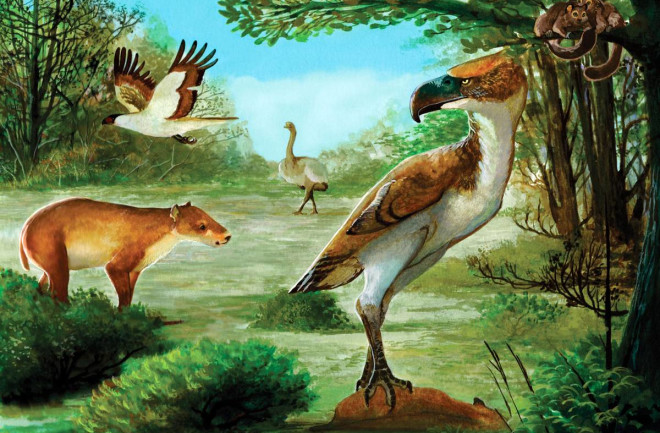The terror bird — an extinct group of carnivorous birds that once dominated the current territory of Argentina, Brazil, Chile, and Uruguay after the extinction of dinosaurs — persisted between 23 million years ago and up to about 17 thousand years ago.
With the head of an eagle, curved beak, body and legs of an African ostrich, and claws as big as those of the Jurassic Park raptors, “you wouldn't want to be in a cage with one of them,” remarked Washington Jones, a paleo-ornithologist at the National Museum of Natural History of Uruguay (MNHN). This beast could also weigh 220 pounds and effortlessly tear flesh.
A recent study published in Electronic Paleontology suggests that the terror bird was also at the top of the food chain in Antarctica, much earlier than previously thought at around 50 million years ago.
Antarctica Once was Lush with Life
During the Eocene, Antarctica was neither cold, nor inhospitable, but a land of lush forests and a warm environment that remained connected (or very little separated) from the southern tip of South America, allowing terrestrial mammals to transit without major restrictions.
However, there was a critical absence: there were no known animals large enough to prey or scavenge in the territory that would later become the frigid continent.
During this period, the fauna was predominantly marine, with creatures like penguins and sharks. On land, marsupial mammals and ungulates prevailed, nearly all of which were herbivores, except for a few small species that fed on insects.
The finding of two ungula phalanxes – or toe bones that could be a hoof or claw – on Seymour Island, at the northern end of the Antarctic Peninsula, indicate that a large bird filled that vacant spot at the top of the food chain.
Read More: Ancient Bird Shakes Up Avian Evolution
Finding the Terror Bird
The bones were not just any part of a leg, but rather a distinctive claw that had a highly specialized function: holding prey to kill it with a beak, according to Jones and colleague from the Faculty of Natural Sciences of the National University of La Plata (UNLP) in Argentina, paleontologist Carolina Acosta Hospitaleche.
Researchers estimated the age of the specimen to be 50 million years old because of the soil layer where the phalanges were found. But the team thought this age was too old. The timeframe precedes the peak period of the Phorusrhacidae, the official name given to 17 species of birds characterized by dagger-like beaks.
Can experts classify the predatory bird of Antarctica as Phorusrhacidae? Jones and Acosta Hospitaleche prefer to refer to it within the Cariamiformes order, which includes the Phorusrhacidae family.
The lack of a specific surname is because the phalanges share characteristics with these birds of terror (with estimated dimensions of 6 feet in height and weight of approximately 220 pounds, akin to Phorusrhacidae longissimus), yet their shape more closely resembles that of their only actual relative: the terrestrial predator known as the seriema (Cariama cristata and Chunga burmeisteri).
The fact that this creature exhibits characteristics of both groups could help fill the informational gap concerning the most primitive members of the Phorusrhacidae. It could also reveal a previously unknown parallel lineage.
Read More: One of the Earliest Birds Ever Discovered Has Rare, Stork-Like Legs
What Makes the Terror Bird so Terrifying?
However, researchers agree that the nickname "terror bird" is well-deserved. Acosta Hospitaleche says, "With its size and those curved claws, it had what was necessary: its purpose was to hunt and tear meat."
The Argentine paleo-ornithologist Federico Degrange, a researcher at the Earth Sciences Research Center of the National University of Córdoba who was not involved in this study, prefers to be more cautious and adheres to the description of it as a "large predatory bird" due to the lack of other skeletal pieces.
Degrange does acknowledge that the characteristics are consistent with a bird adapted to terrestrial life. By not classifying it as a Phorusrhacidae, he maintains that the oldest credible record should be that of a fossil from Patagonia dating to the middle Eocene, approximately 44 million years ago.
On the other hand, the label "terror bird" is unmistakable for Felipe Montenegro, a paleontologist at the Faculty of Sciences of the University of the Republic (Uruguay), who has studied the aerodynamics of terror birds and was not involved in this research.
"This discovery allows us to envision what the fauna assemblages were like in the forests of Antarctica," Montenegro says. He also believes that the work of Jones and Acosta Hospitaleche provides insights into the ecological roles of predatory birds at the end of the ice age, when their weight had decreased to about 33 pounds.
"We could start to imagine the interactions between these creatures and the first Paleo-Indians of South America might have been like," says Montenegro.
Read More: What Elephant Bird Eggs Reveal About the Biggest Bird to Ever Live
Article Sources
Our writers at Discovermagazine.com use peer-reviewed studies and high-quality sources for our articles, and our editors review for scientific accuracy and editorial standards. Review the sources used below for this article:
Electronic Palaeontology. Were terror birds the apex continental predators of Antarctica? New findings in the early Eocene of Seymour Island.

